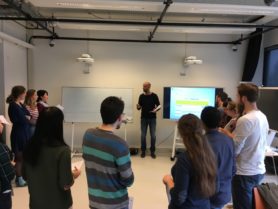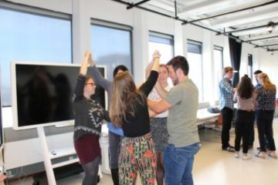Good practices
Letting students work on their skills in the TLL
The elective course Co-create: life’s professional challenges stimulates students to solve a problem in society in an innovative way. Twenty third-year bachelor, master and recently graduated students from all faculties at Utrecht University worked on Loneliness in Utrecht for two weeks as a team. The TLL served as the home base for the course.
The course targeted skill development, and was taught by Heleen van Ravenswaaij who is doing PhD research into skills. She taught the course together with colleagues from UMC Utrecht, Career Offices and the Utrecht local authority.

Content of the course
Guest lecturers with an expertise relating to the topic of loneliness or in relation to a skill (such as giving feedback) presented workshops and short seminars. Students could also ask for coaching. To finalise the course, each team presented a concept solution to a jury, with the winning team focusing on connection older people and children through presenting talks. In addition students worked individually on their own professional development by gaining understanding of for instance team roles, personality and strong and weak characteristics.
Varied ways of working
During the course many different ways of working were used, and the TLL could be easily adapted to them. With the first day focusing on teambuilding, all the furniture was moved to the side. During teamwork the groups could choose for themselves whether to sit or to stand using the adjustable tables. Variation makes it much easier to remain concentrated during a long day from 9 to 5. During an interactive workshop it was easy to create a circle of chairs, followed by putting the movable screens wherever they were needed, so that not all students had to look at the same display.
Some of the students made use of the TLL studio for their individual professional development. Using the DIY function (Do It Yourself) they recorded a short 2-minute clip about their qualities and points to improve.
Interactive wall
 In addition to the furniture the interactive wall in the TLL was used. This wall projects a canvas which you can work on via a laptop or tablet, but also on the wall itself. This allowed the wall to be used as a source of information, for instance by creating a laundry line with student information to guide the process of forming a group. It also functioned more as a working method, with students giving each other peer feedback by filling in a SWOT analysis of their concept analysis on the wall. Some advantages of this way of working are that because of the size of the display the information is easily visible to more students at a time and that using the wall requires a more active approach from students.
In addition to the furniture the interactive wall in the TLL was used. This wall projects a canvas which you can work on via a laptop or tablet, but also on the wall itself. This allowed the wall to be used as a source of information, for instance by creating a laundry line with student information to guide the process of forming a group. It also functioned more as a working method, with students giving each other peer feedback by filling in a SWOT analysis of their concept analysis on the wall. Some advantages of this way of working are that because of the size of the display the information is easily visible to more students at a time and that using the wall requires a more active approach from students.
Heleen would like to research the group processes in more detail for her PhD research by using the TLL observation cameras.
Author: Heleen van Ravenswaaij (UMC Utrecht)



